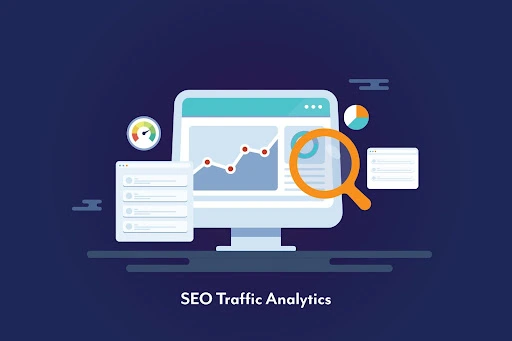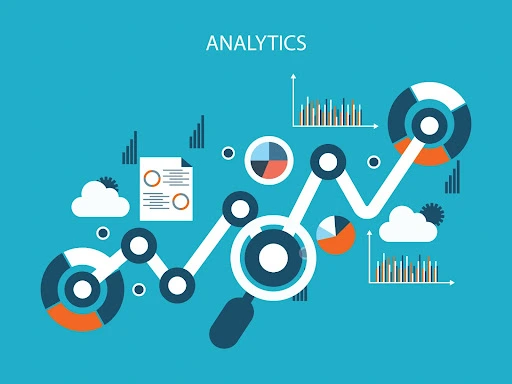Understanding SEO Analytics: A Beginner’s Guide

In the present era of digitalization, simply owning a website is no longer sufficient. It has become indispensable to optimize your website in order to secure a high rank on the search engine results pages (SERPs) for relevant keywords. This optimization process is commonly known as Search Engine Optimization (SEO), and it plays a pivotal role in increasing the traffic on your website and generating leads. However, how can you ensure that your SEO efforts are bearing fruit? This is where the concept of SEO analytics enters the picture.
What is SEO Analytics?
The practice of SEO analytics involves the monitoring, measurement, and analysis of your website’s SEO performance. This entails employing various tools to gather data on a multitude of metrics, such as organic traffic, keyword rankings, backlinks, and much more. By meticulously scrutinizing this data, you can gain valuable insights into the effectiveness of your SEO strategies and make decisions grounded in data to enhance your website’s performance.
This guide is aimed towards beginners and aims to provide an overview of the fundamental aspects of SEO analytics. It will enlighten you on the meaning of SEO analytics, the mechanisms that drive it, and its potential to bolster your website’s performance.
SEO analytics is essential as it helps you to gauge your website’s performance in SERPs. By keeping track of your website’s performance, you can identify which areas require improvement and make informed decisions to optimize your website for search engines. As a result, you can achieve higher rankings in SERPs, increase organic traffic, and generate more leads and conversions.
How SEO Analytics Works
SEO analytics works by collecting and analyzing various metrics, such as organic traffic, keyword rankings, backlinks, and others. You can use tools such as Google Analytics, SEMrush, or Ahrefs to collect and analyze this data.
Organic traffic is one of the primary metrics that SEO analytics tools track. It refers to the number of visitors to your website that come from search engines. By keeping track of organic traffic, you can analyze how many people are finding your website through search engines and how this number changes over time.
Keyword rankings are also crucial metrics that SEO analytics tools track. They indicate how well your website ranks for specific keywords in SERPs. By monitoring your keyword rankings, you can analyze which keywords are driving traffic to your website and how well you are ranking for those keywords compared to your competitors.
Backlinks are another important metric that SEO analytics tools track. They refer to the number of links from other websites that point to your website. By monitoring your backlinks, you can analyze how many other websites are linking to your website and how this number changes over time. Backlinks are significant because they signal to search engines that other websites consider your content to be valuable and relevant.
Here’s How to Use SEO Analytics
After reviewing the fundamentals of SEO analytics, let’s explore how you can use it to enhance your website’s performance. Below are some tips:
- Monitor organic traffic: By keeping track of your organic traffic, you can see how many people are finding your website through search engines and how this figure changes over time. If your organic traffic is decreasing, it may indicate that your SEO efforts need improvement.
- Track keyword rankings: By monitoring your keyword rankings, you can see which keywords are driving traffic to your website and how well you are ranking for those keywords compared to your competitors. This data can help you identify opportunities to enhance your rankings for specific keywords.
- Analyze backlinks: By analyzing your backlinks, you can see how many other websites are linking to your website and how this number changes over time.
- Identify areas for improvement: By analyzing your SEO analytics data, you can recognize areas of your website that require improvement. For instance, if you’re not ranking well for a specific keyword, you may need to optimize your content or build more backlinks. If your bounce rate is high, you may need to improve your website’s user experience.
- Set goals and track progress: It’s crucial to set goals for your SEO efforts and monitor your progress over time. By setting specific, measurable, and achievable goals, you can ensure that you’re making progress towards improving your website’s performance.
- Use SEO analytics tools: There are numerous tools available that can help you gather and analyze your SEO analytics data. Some of the most popular tools include Google Analytics, SEMrush, and Ahrefs.
- Stay up to date with SEO best practices: SEO best practices are continuously evolving, and it’s critical to stay current with the latest trends and techniques. By staying informed, you can ensure that your SEO strategies are effective and up to date.
In conclusion, SEO analytics is a critical aspect of any SEO strategy. By gathering and analyzing data on your website’s performance, you can obtain valuable insights into what is working and what isn’t. This information can help you make data-driven decisions to optimize your website for search engines, resulting in higher rankings in SERPs, increased organic traffic, and more leads and conversions.
Remember, SEO is an ongoing process that requires continuous attention and optimization to ensure that your website is performing at its best. By using SEO analytics to monitor your website’s performance and identify areas for improvement, you can stay ahead of the competition and achieve your business goals.
FAQs
SEO analytics pertains to the collection, analysis, and interpretation of data concerning the performance of a website on search engines. It involves monitoring various metrics to gain insights into the website’s ranking on search engine results pages (SERPs) and user interactions. SEO analytics holds immense importance as it provides valuable information about a website’s visibility, user engagement, and effectiveness in attracting organic search traffic.
To begin with SEO analytics, individuals must first establish a robust analytics tool. Popular options include Google Analytics or specialized SEO tools like Moz or SEMrush. These powerful resources aid in tracking and analyzing diverse metrics regarding website performance. Once the setup process is complete, it’s essential to define clear goals and objectives for your SEO efforts. Examples may involve improving search rankings, increasing organic traffic, or enhancing user engagement.
Several key metrics are essential to track in SEO analytics:
Organic Traffic: This is a metric that quantifies the number of website visitors originating from search engine platforms.
Keyword Rankings: The search visibility of your targeted keywords can be effectively tracked by monitoring their rankings in search results.
Click-Through Rate (CTR): This reveals the proportion of users who clicked on your link after encountering it in search results.
SEO analytics offers valuable insights into the performance of your website, empowering you to pinpoint its strengths and weaknesses. By scrutinizing key metrics such as keyword rankings, click-through rates (CTR), and bounce rate, you can gain a deep understanding of which pages are excelling and which ones require improvement.
SEO analytics provide valuable insights into audience behavior. By analyzing user data, including search queries, page duration, and click patterns, you can gain a deeper understanding of users’ needs and site navigation.
There are various tools available, each catering to different needs and levels of expertise. Among these options are popular choices like Google Analytics, which provides an overview of website performance, and Google Search Console for monitoring search performance.
SEO analytics assists in identifying improvement opportunities by unveiling patterns and trends within the performance data of your website. Keep an eye out for pages experiencing high bounce rates, keywords demonstrating satisfactory performance yet having room for further enhancement, or pages that rank on the second page of search results. By addressing these aspects, you can optimize your content, enhance user experience, and refine your SEO strategies to seize untapped potential.
SEO analytics plays a vital role in monitoring the efficacy of your SEO strategies. By examining data before and after implementing specific tactics, you can assess the impact of your changes. For instance, if you optimize a webpage for certain keywords, you can track how those keywords’ rankings and organic traffic have progressed over time. This data-driven approach empowers you to evaluate strategy effectiveness and make necessary adjustments.
SEO analytics provide valuable insights into the online presence of your competitors. By analyzing their keyword rankings, backlink profiles, and overall performance, you can uncover successful strategies employed by them. This knowledge will empower you to adapt and refine your own tactics. It also ensures the competitiveness within your industry.
In the realm of SEO analytics, individuals often encounter several common challenges. These hurdles encompass issues with data accuracy, attribution modeling, and comprehending complex metrics. To successfully overcome these obstacles, it is crucial to ensure proper configuration of your analytics tools along with utilizing reliable data sources. Moreover, exploring different attribution models will allow for a comprehensive understanding of the complete user journey and enable appropriate credit allocation to various touchpoints.
Categories
- AI
- ChatGPT
- Content Marketing
- Content Marketing & Strategy
- Digital Marketing
- Entrepreneurship
- Google Analytics
- Google Tag Manager
- Google Updates
- Influencer Marketing
- Mobile App Marketing
- Paid Marketing
- Press
- Pubcon
- Search Engine Marketing
- Search Engine Optimization
- SEO
- SEO Tools
- Social Media Marketing
Recent Posts
- How do I Verify My Business on Google to Ace Local SEO? March 17, 2025
- The Pros and Cons of Pay For Performance SEO March 17, 2025
- Website Structure for SEO: A Blueprint for Better Rankings March 17, 2025
- Keyword Cannibalization: Why It Matters for Your Company and How to Avoid It March 12, 2025
- SEO for Bing: Unlocking Opportunities for Business Owners and Marketers March 11, 2025
- Google Cached Websites: A Quick Guide to Accessing Them March 5, 2025
- Programmatic Advertising: Stop Just Talking About It, and Start Driving Real Growth (A Business Leader’s Guide to Cutting Through the Hype) March 4, 2025
- How to Use Google Trends: The Ultimate Guide for SEO & Content Marketers March 4, 2025
- Farewell, Skype: It’s the End of an Era March 3, 2025
- How to Plan and Execute a Website Migration Without Losing Rankings? February 28, 2025
Get
in Touch
Contact AdLift for a 360-degree marketing plan


